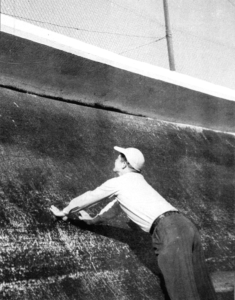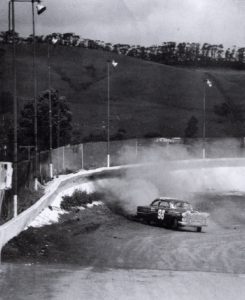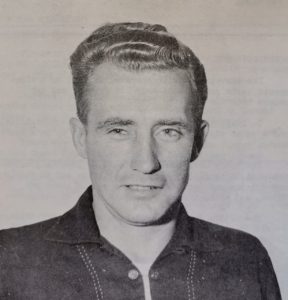By Vincent Delforge, special to KickinTheTires.net
It was in Oakland, California at Oakland Stadium, an atypical half-mile oval that the very first race in the history of the West Series, known at the time as NASCAR Pacific Coast Late Model Division, the current ARCA Menards West Series. A race combined with the Grand National Division, the current NASCAR Cup Series.

To be atypical, Oakland Stadium was! Built in 1931, it has known different configurations. In 1946, it was .625 miles long, and completely paved. Despite its reduction to half a mile in the early 1950s, the terrible constraints caused by cars leaning on its banking of 45 degrees on one side and almost 62 degrees on the other, yes you read that right, a real wall, had particularly degraded it.
The laws of gravity being put to the test. In the event of a slowdown, the roll to the inside of the turn was inevitable! In 1954 it was in very poor condition, which did not prevent races from being organized there on a kind of mix between paved track and dirt track. Indeed, if the outside of the banked corners was still asphalted, the inside part was now dirt, as was part of the two straight lines.
On March 28, 1954, 26 drivers registered for this first race of 250 laps or 125 miles. It is also the sixth race of the NASCAR Grand National. This is why we find among the local pilots some stars of the national championship like Lee Petty, Hershel McGriff or Dick Rathman.
A practice of one hour followed by a qualifying session and the track is already very damaged. The organizers have tried to pack the ground inside the bends.. in vain. The drivers riding between the inside dirt part relying only with the outer wheels on the asphalt dig a kind of curb between the dirt / asphalt connection. This will cause a lot of mechanical breakage, punctures and other accidents.
Hershel McGriff on his Oldsmobile entered by Beryl Jackson takes pole position in 55.624 mph. He is ahead of Lee Petty and his Dodge who made the trip from Atlanta, GA and the first West Coast driver, local John Soares also on Dodge. A driver has not done a single lap and will start dead last. This is Dick Rathman.
The latter failed to arrive in time despite having driven day and night, without a minute’s sleep, for four days from Chicago, IL. A trip strewn with pitfalls since his car broke down twice… and once he arrived at the circuit, the fuel tank of his racing car came off when he lowered it from the trailer… Time to repair and it’s already the time of the start of the race.
The race is given under a beautiful sun, the air being dry, it will quickly become complicated with the dust raised by the cars. The mechanics will suffer.

Hershel McGriff takes advantage of his pole to escape in the lead. Lee Petty, Ben Gregory and Marvin Panch form a tight second group. Rathman after three more or less slow laps, his engine coughing due to poor fuel delivery, is good last while the leader is already catching up with him. Then suddenly, the problem disappears and he will quickly stick back to the pack and start his ascent.
At the start of lap 21, Bill Weiman tore off the right rear wheel of his Oldsmobile and rolled over. It is the abandonment but fortunately the pilot is not seriously injured. He causes the first yellow flag in the history of the series. It will be the only of the race.
Marvin Panch receives the black flag for overtaking under yellow flag. He is penalized by one lap and will restart dead last.
At the restart, McGriff resumed his cruising speed and seemed to be flying towards victory. After 50 laps there are already only 15 drivers left in the leader’s lap. The abandonments will follow from this moment. For seven drivers, the reason will be the breakage of the tie rod. Because of the state of the turns. Holes, nearly “gullies”, forming as you go. The first victims are Art Watts, Woody Brown, Richard Brown, Bill Amick… and Hershel McGriff who suddenly loses speed shortly after the 120th lap.
He was almost a lap ahead of the group of his closest pursuers, led by Marvin Panch. Panch who had driven like crazy to come back from behind. The Dodge No. 98 driver took control on lap 126. He will keep this position until his stop in the pit on the 142nd lap. His team having to put water in his radiator which is overheating.
Dick Rathman, who also had pushed his car hard to get back to the leaders, did not ask for time and took the lead of the race on the 143rd lap. Seeing Panch’s problems, he decides to slow down a bit so as not to suffer the same fate. After a quick passage through his pit to drink some water and clean his face and eyes full of dust, he will be up to two laps ahead of Panch and Soares with 50 laps to go out of the 250.
Despite a final charge, Marvin Panch only managed to regain one of his two laps behind. Rathman controls the race and luckily he has reduced the pace because he finishes with only the fumes left in the gas tank… out of gas 200 feet after taking the checkered flag! It doesn’t matter in the end, he wins, in front of 8,500 spectators, with his Hudson Hornet No. 3 entered by Ray Erickson the first race in the history of the West Series after two hours 27 minutes and 57 seconds in dantesque conditions at an average of 50.692 mph.
He pockets the $1,000 promised to the winner, a very nice check at the time. It’s a great performance. As a reminder, he started the race dead last. This race being combined with the national series, it also makes Rathman the first “last to first” winner in NASCAR Grand National history.

Marvin Panch finished second with a lap down. Without his penalty lap, he would not have overheated his mechanics by driving beyond the limits and the outcome could have been different. But we will never know. John Soares, with a flat right front tire, finished third three laps down. Behind the gaps are abysmal with Clyde Palmer at 12 laps and the future first series champion Lloyd Dane at 14 laps!
The rest of the top 10 is completed by Lee Petty, Sam Hawks, Bob Havemann, Jim Heath and Jim Cook.
Rathman’s race was therefore a clever mix between full attack mode and efficient mechanical management mode. In 2022, nearly 1000 races later, it is still this same recipe that makes the difference and allows drivers to win races in the West Series.
As Alan Ward, sports editor of the Oakland Tribune wrote of Rathman’s race: “Not only rivaled fiction, but beat fiction all hollow…a less talented pilot would never have made it!”
Note that among the manufacturers involved in this first race, only Chevrolet is still present today.
Full results here: www.racing-reference.info/race-results/1954-01/P/
Sources:
-Oakland Tribune March 29, 1954
-NASCAR Bulletin April 6, 1954
-NASCAR Newsletter April 8, 1954 Vol. 4 No. 7
-Oakland Stadium race program August 1, 1954
-NASCAR Record Book 1954 racing season
-Forty Years of Stock Car Racing “The Beginning 1949-1958” by Greg Fielden Fourth printing, revised edition, August 1995
-Stock Car Racing Encyclopedia by Peter Golenbock and Greg Fielden, 1997
Featured Photo Credit: Ward & Simpson Photo via Vincent Delforge’s Archives.